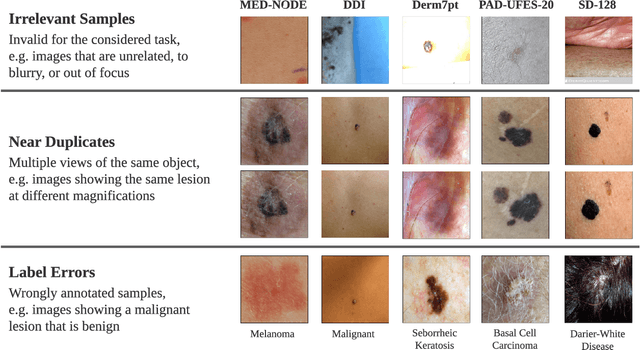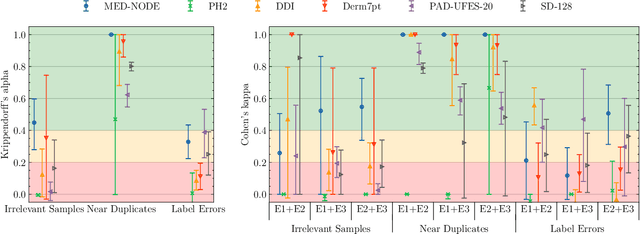Roxana Daneshjou
Stanford University
BiasICL: In-Context Learning and Demographic Biases of Vision Language Models
Mar 04, 2025Abstract:Vision language models (VLMs) show promise in medical diagnosis, but their performance across demographic subgroups when using in-context learning (ICL) remains poorly understood. We examine how the demographic composition of demonstration examples affects VLM performance in two medical imaging tasks: skin lesion malignancy prediction and pneumothorax detection from chest radiographs. Our analysis reveals that ICL influences model predictions through multiple mechanisms: (1) ICL allows VLMs to learn subgroup-specific disease base rates from prompts and (2) ICL leads VLMs to make predictions that perform differently across demographic groups, even after controlling for subgroup-specific disease base rates. Our empirical results inform best-practices for prompting current VLMs (specifically examining demographic subgroup performance, and matching base rates of labels to target distribution at a bulk level and within subgroups), while also suggesting next steps for improving our theoretical understanding of these models.
SycEval: Evaluating LLM Sycophancy
Feb 12, 2025Abstract:Large language models (LLMs) are increasingly applied in educational, clinical, and professional settings, but their tendency for sycophancy -- prioritizing user agreement over independent reasoning -- poses risks to reliability. This study introduces a framework to evaluate sycophantic behavior in ChatGPT-4o, Claude-Sonnet, and Gemini-1.5-Pro across AMPS (mathematics) and MedQuad (medical advice) datasets. Sycophantic behavior was observed in 58.19% of cases, with Gemini exhibiting the highest rate (62.47%) and ChatGPT the lowest (56.71%). Progressive sycophancy, leading to correct answers, occurred in 43.52% of cases, while regressive sycophancy, leading to incorrect answers, was observed in 14.66%. Preemptive rebuttals demonstrated significantly higher sycophancy rates than in-context rebuttals (61.75% vs. 56.52%, $Z=5.87$, $p<0.001$), particularly in computational tasks, where regressive sycophancy increased significantly (preemptive: 8.13%, in-context: 3.54%, $p<0.001$). Simple rebuttals maximized progressive sycophancy ($Z=6.59$, $p<0.001$), while citation-based rebuttals exhibited the highest regressive rates ($Z=6.59$, $p<0.001$). Sycophantic behavior showed high persistence (78.5%, 95% CI: [77.2%, 79.8%]) regardless of context or model. These findings emphasize the risks and opportunities of deploying LLMs in structured and dynamic domains, offering insights into prompt programming and model optimization for safer AI applications.
Best Practices for Large Language Models in Radiology
Dec 02, 2024



Abstract:At the heart of radiological practice is the challenge of integrating complex imaging data with clinical information to produce actionable insights. Nuanced application of language is key for various activities, including managing requests, describing and interpreting imaging findings in the context of clinical data, and concisely documenting and communicating the outcomes. The emergence of large language models (LLMs) offers an opportunity to improve the management and interpretation of the vast data in radiology. Despite being primarily general-purpose, these advanced computational models demonstrate impressive capabilities in specialized language-related tasks, even without specific training. Unlocking the potential of LLMs for radiology requires basic understanding of their foundations and a strategic approach to navigate their idiosyncrasies. This review, drawing from practical radiology and machine learning expertise and recent literature, provides readers insight into the potential of LLMs in radiology. It examines best practices that have so far stood the test of time in the rapidly evolving landscape of LLMs. This includes practical advice for optimizing LLM characteristics for radiology practices along with limitations, effective prompting, and fine-tuning strategies.
Almanac Copilot: Towards Autonomous Electronic Health Record Navigation
May 14, 2024



Abstract:Clinicians spend large amounts of time on clinical documentation, and inefficiencies impact quality of care and increase clinician burnout. Despite the promise of electronic medical records (EMR), the transition from paper-based records has been negatively associated with clinician wellness, in part due to poor user experience, increased burden of documentation, and alert fatigue. In this study, we present Almanac Copilot, an autonomous agent capable of assisting clinicians with EMR-specific tasks such as information retrieval and order placement. On EHR-QA, a synthetic evaluation dataset of 300 common EHR queries based on real patient data, Almanac Copilot obtains a successful task completion rate of 74% (n = 221 tasks) with a mean score of 2.45 over 3 (95% CI:2.34-2.56). By automating routine tasks and streamlining the documentation process, our findings highlight the significant potential of autonomous agents to mitigate the cognitive load imposed on clinicians by current EMR systems.
Assessing The Potential Of Mid-Sized Language Models For Clinical QA
Apr 24, 2024



Abstract:Large language models, such as GPT-4 and Med-PaLM, have shown impressive performance on clinical tasks; however, they require access to compute, are closed-source, and cannot be deployed on device. Mid-size models such as BioGPT-large, BioMedLM, LLaMA 2, and Mistral 7B avoid these drawbacks, but their capacity for clinical tasks has been understudied. To help assess their potential for clinical use and help researchers decide which model they should use, we compare their performance on two clinical question-answering (QA) tasks: MedQA and consumer query answering. We find that Mistral 7B is the best performing model, winning on all benchmarks and outperforming models trained specifically for the biomedical domain. While Mistral 7B's MedQA score of 63.0% approaches the original Med-PaLM, and it often can produce plausible responses to consumer health queries, room for improvement still exists. This study provides the first head-to-head assessment of open source mid-sized models on clinical tasks.
BioMedLM: A 2.7B Parameter Language Model Trained On Biomedical Text
Mar 27, 2024Abstract:Models such as GPT-4 and Med-PaLM 2 have demonstrated impressive performance on a wide variety of biomedical NLP tasks. However, these models have hundreds of billions of parameters, are computationally expensive to run, require users to send their input data over the internet, and are trained on unknown data sources. Can smaller, more targeted models compete? To address this question, we build and release BioMedLM, a 2.7 billion parameter GPT-style autoregressive model trained exclusively on PubMed abstracts and full articles. When fine-tuned, BioMedLM can produce strong multiple-choice biomedical question-answering results competitive with much larger models, such as achieving a score of 57.3% on MedMCQA (dev) and 69.0% on the MMLU Medical Genetics exam. BioMedLM can also be fine-tuned to produce useful answers to patient questions on medical topics. This demonstrates that smaller models can potentially serve as transparent, privacy-preserving, economical and environmentally friendly foundations for particular NLP applications, such as in biomedicine. The model is available on the Hugging Face Hub: https://huggingface.co/stanford-crfm/BioMedLM.
RIDGE: Reproducibility, Integrity, Dependability, Generalizability, and Efficiency Assessment of Medical Image Segmentation Models
Jan 16, 2024
Abstract:Deep learning techniques, despite their potential, often suffer from a lack of reproducibility and generalizability, impeding their clinical adoption. Image segmentation is one of the critical tasks in medical image analysis, in which one or several regions/volumes of interest should be annotated. This paper introduces the RIDGE checklist, a framework for assessing the Reproducibility, Integrity, Dependability, Generalizability, and Efficiency of deep learning-based medical image segmentation models. The checklist serves as a guide for researchers to enhance the quality and transparency of their work, ensuring that segmentation models are not only scientifically sound but also clinically relevant.
Towards Reliable Dermatology Evaluation Benchmarks
Sep 13, 2023



Abstract:Benchmark datasets for digital dermatology unwittingly contain inaccuracies that reduce trust in model performance estimates. We propose a resource-efficient data cleaning protocol to identify issues that escaped previous curation. The protocol leverages an existing algorithmic cleaning strategy and is followed by a confirmation process terminated by an intuitive stopping criterion. Based on confirmation by multiple dermatologists, we remove irrelevant samples and near duplicates and estimate the percentage of label errors in six dermatology image datasets for model evaluation promoted by the International Skin Imaging Collaboration. Along with this paper, we publish revised file lists for each dataset which should be used for model evaluation. Our work paves the way for more trustworthy performance assessment in digital dermatology.
Large language models in medicine: the potentials and pitfalls
Aug 31, 2023Abstract:Large language models (LLMs) have been applied to tasks in healthcare, ranging from medical exam questions to responding to patient questions. With increasing institutional partnerships between companies producing LLMs and healthcare systems, real world clinical application is coming closer to reality. As these models gain traction, it is essential for healthcare practitioners to understand what LLMs are, their development, their current and potential applications, and the associated pitfalls when utilized in medicine. This review and accompanying tutorial aim to give an overview of these topics to aid healthcare practitioners in understanding the rapidly changing landscape of LLMs as applied to medicine.
Augmenting medical image classifiers with synthetic data from latent diffusion models
Aug 23, 2023



Abstract:While hundreds of artificial intelligence (AI) algorithms are now approved or cleared by the US Food and Drugs Administration (FDA), many studies have shown inconsistent generalization or latent bias, particularly for underrepresented populations. Some have proposed that generative AI could reduce the need for real data, but its utility in model development remains unclear. Skin disease serves as a useful case study in synthetic image generation due to the diversity of disease appearance, particularly across the protected attribute of skin tone. Here we show that latent diffusion models can scalably generate images of skin disease and that augmenting model training with these data improves performance in data-limited settings. These performance gains saturate at synthetic-to-real image ratios above 10:1 and are substantially smaller than the gains obtained from adding real images. As part of our analysis, we generate and analyze a new dataset of 458,920 synthetic images produced using several generation strategies. Our results suggest that synthetic data could serve as a force-multiplier for model development, but the collection of diverse real-world data remains the most important step to improve medical AI algorithms.
 Add to Chrome
Add to Chrome Add to Firefox
Add to Firefox Add to Edge
Add to Edge